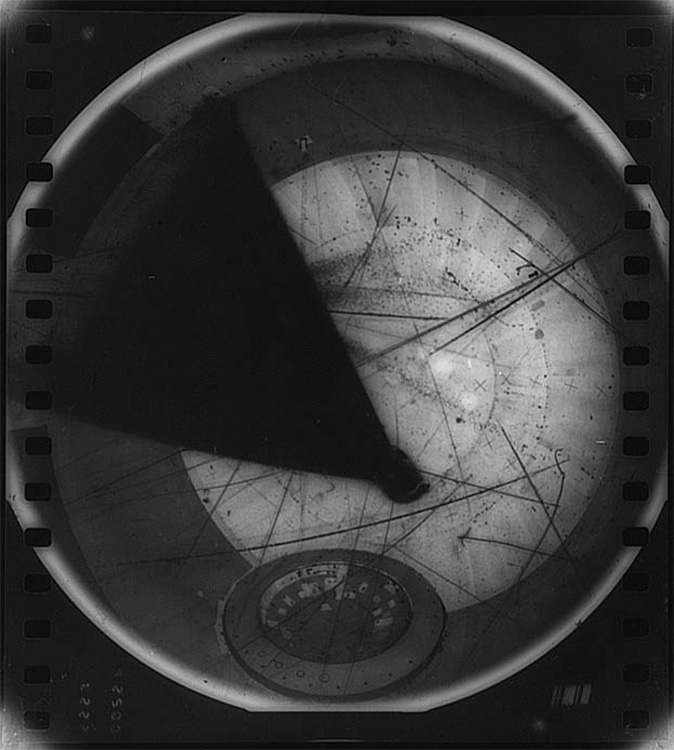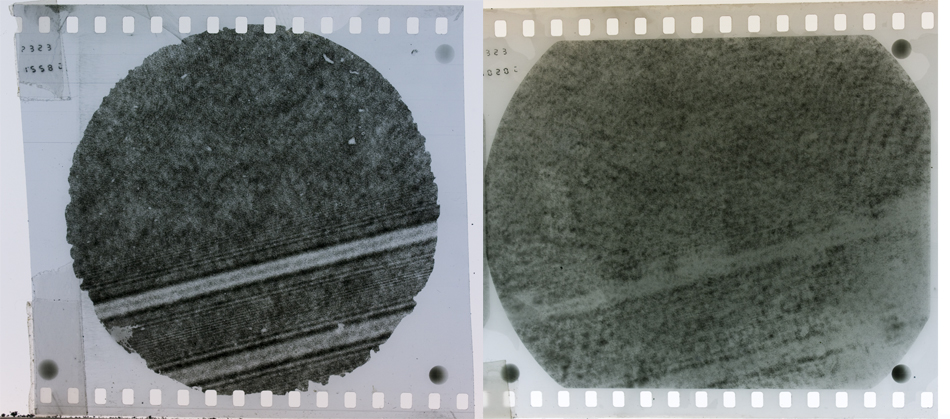
It’s a shame that Dennis Gabor did not live to see or hear about the grandest implementation of his new microscopic principle, holography of particle tracks in the 15 foot bubble chamber at Fermi National Accelerator Laboratory in the mid-1980’s.
Bubble chambers have been around about as long as I have. Gabor would have undoubtedly known of them as a practicing physicist in the early 1950’s. Go to Wikipedia or Google the topic for more background, and note especially the fact that the particle tracks in bubble chambers were recorded photographically.
Fermilab’s Bubble Chamber was the first target built in the neutrino line of fire from the accelerator and started operation in 1973. The Tevatron would fling sub-atomic particles at a 15 foot diameter sphere filled with 50 kiloLiters of liquid hydrogen, and the particles create an ionization track, around which the liquid vaporizes, forming microscopic bubbles. They sort of look like what happens in a glass of beer, but a couple of order of magnitudes smaller.
There were six 70mm film cameras looking down into the Bubble Chamber. Each camera was equipped with a wide angle lens to see as much of the bubble chamber as possible. Xenon flash tubes surrounded the lenses as ring lights. The entire interior of the Bubble Chamber was covered with ScotchLite, (commonly found on road signs which light up brightly when a headlight hits it), which is a contact paper that has micro beads of glass to retro-reflect the flash light back up to the camera’s lens for a bright background. Since the bubbles in the chamber are voids in a higher index of refraction liquid, they act as positive lenses, which disperse the light that hits them, first on its way down into the chamber from the flash, and also when it get retro-reflected back up to the camera. The bubbles then photograph dark against the bright background.
Depending on the collision event, the particle tracks take a variety of shapes, not unlike skidmarks at the scene of a vehicle collision. Physicists could deduce the nature of the interaction from these curlicues.
Many wonderful discoveries were made in bubble chambers, but the tracks of what the physicists were looking for at that time would have a short length, and be composed of very tiny bubbles. There is a limit to the smallest thing a lens is able to resolve, and these tracks were at that limit.
Enter holograms as a solution to this problem; they can have higher resolution than photographic lenses. Preliminary tests of the concept were initiated at CERN in 1983, and then implemented in 1985 at FermiLab for its next big physics run, under the aegis of Experiment 632.
The holographic set up was extremely simple: the in-line transmission scheme of our dear departed Gabor! A special lens dispersed the ruby laser beam before it entered the chamber, so that most of the light fanned out to illuminate as much of the bubble chamber as possible, with its central rays heading directly to the holographic film in one of the photographic camera;s film transport, except sans lens. The bubbles again acted as lenses, diverging the 694 nm light so that some of it would reach the holographic film from its position. The bubble tracks holographed as bright points against a black background, the opposite of the photographs.
However, there is, in physics, the observer effect, which is the fact that simply observing a situation or phenomenon necessarily changes that phenomenon. And it turned out that the laser light used to expose the hologram was stronger than the incoming accelerated particles, causing the liquid hydrogen to boil in its beam path, as in the photograph below.

One of the conventional photographic cameras captures the ruby laser beam exiting from a window near the bottom of the bubble chamber. The diverging beam obliterates all the particle tracks in its path!
This drawback was known from the work at CERN. The solution was to lower the peak power of the laser by extending the pulse width, which kept the exposure energy high enough for the hologram but under the boiling threshold of the liquid hydrogen, as photo-and holo-graphic exposure is a function of time times intensity, E = I X t. It’s like filling a cup up with water; higher flow (or intensity) requires less time to accomplish the mission, less light more time.
The first major problem with this solution was in changing the pulse width of the ruby laser. The typical Q-Switched ruby laser pulse width is 20 nanoseconds, for more details on ruby lasers check this out.
Electronic technicians at Fermi built a circuit that would sample the light from the oscillator from a leaky rear reflector, send it into an analog circuit that would dither the Pockel’s cell to let some light out but not all, over an extended period of time. All this happens in a blink of an eye, from the stock JK Q-switch 20 nanoseconds to pulses extending to 3 and even 4 orders of magnitude, like 10 to 100 microseconds! And then the peak laser power is cranked down the same amount, below the threshold of boiling of the liquid hydrogen.
So holograms could be exposed without bothering the photographs; however, the #1 Killer of Holograms, Movement during Exposure, reared its ugly head! This time note in the picture above the disc directly at the bottom of the Bubble Chamber. It is attached to a piston which drops down toward the ground, enlarging the volume of the chamber, lowering the pressure in it, so that it becomes more sensitive to the incoming radiation. It would shake the whole building when it plunged!
So during those pulse-stretched exposures there would be enough movement of the apparatus to blur out the fringes! The proof follows.

Stretched across the fiducial volume of the Bubble Chamber were wires to calibrate the positions of tracks for the photographic cameras. Two of those wires were in the reference beam path of the hologram. On the left is a hologram taken either with a 20 ns Q-Switched pulse or the Bubble Chamber was still, or maybe even both. The diffracted shadows of the wires come out textbook perfect, with a bright fringe in the center of the geometric shadow and fringes of increasing spatial frequency radiating from it. On the right is a hologram from a physics run, and if it’s hard enough to see those shadows in the macroscopic world, what about in the microscopic world of the holographic interference pattern?
So hundreds of thousands of holograms were shot, but to what avail? They were dim, if there at all, even though the world’s largest ruby laser ever made, (at $130k of our tax dollars!) was used to record them, but in a flawed scheme.
Check out this link to see some of the equipment and environs of FermiLab.